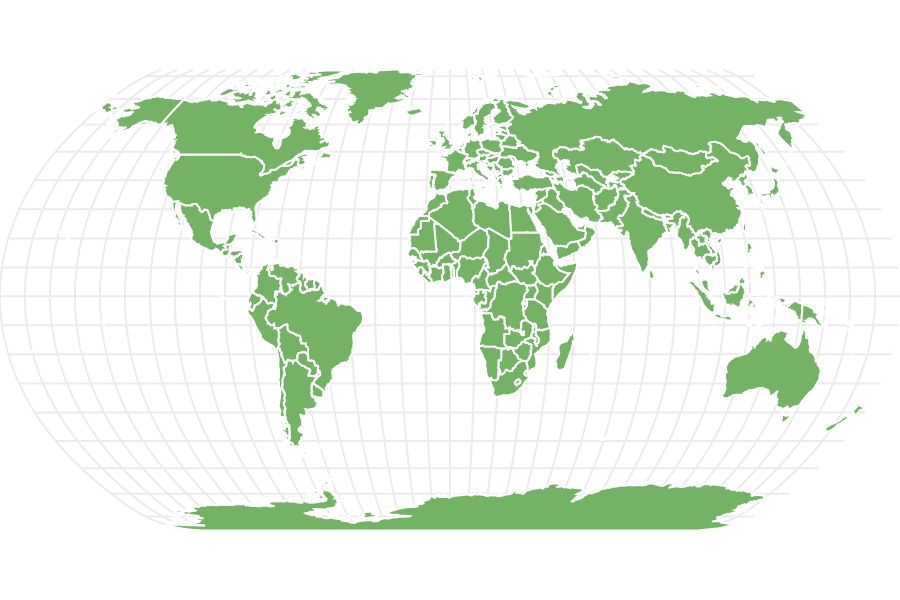Chinstrap Penguin
Pygoscelis Antarcticus
There are 7 million breeding pairs!
Advertisement
Chinstrap Penguin Scientific Classification
- Kingdom
- Animalia
- Phylum
- Chordata
- Class
- Aves
- Order
- Sphenisciformes
- Family
- Spheniscidae
- Genus
- Pygoscelis
- Scientific Name
- Pygoscelis Antarcticus
Read our Complete Guide to Classification of Animals.
Chinstrap Penguin Conservation Status
Chinstrap Penguin Facts
- Main Prey
- Krill, Fish, Shrimp
- Distinctive Feature
- White face and thin, black line that runs under the chin
- Habitat
- Rocky Antarctic Islands
- Predators
- Leopard Seal, Killer Whale, Sea Birds
- Diet
- Carnivore
- Average Litter Size
- 2
- Lifestyle
- Colony
- Favorite Food
- Krill
- Type
- Bird
- Slogan
- There are 7 million breeding pairs!
View all of the Chinstrap Penguin images!
“The largest chinstrap penguin colony has more penguins than San Francisco has people!”
The chinstrap penguin is the most abundant of all penguin species. In fact, one of their colonies has more than a million breeding pairs of penguins on a remote island!
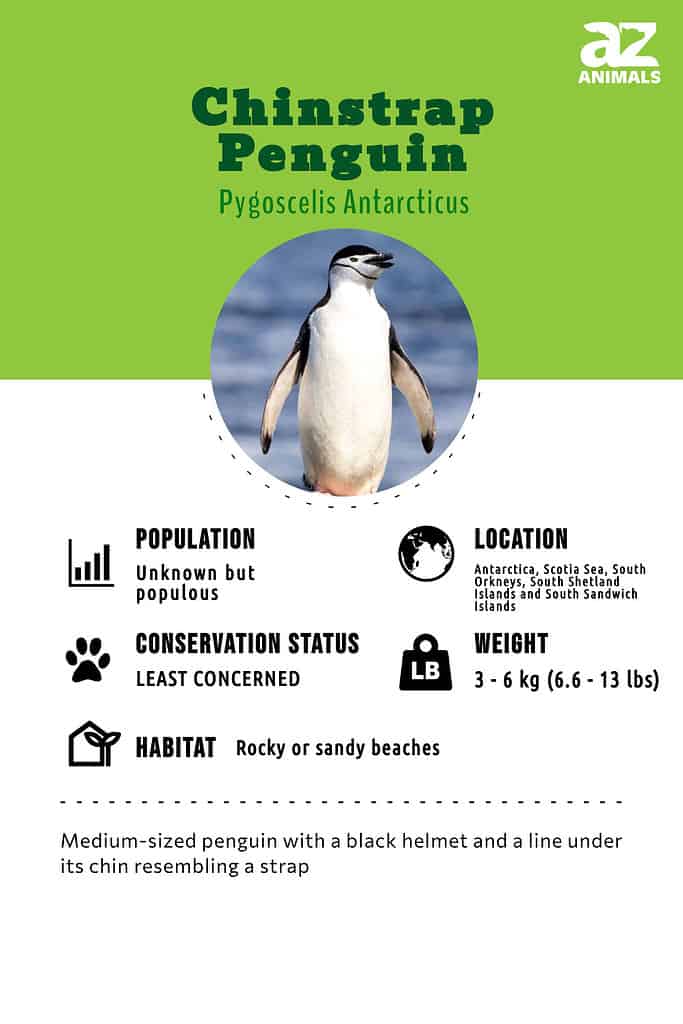
Incredible Chinstrap Penguin Facts!
- The chinstrap penguin colony on Zavodovski Island in the South Atlantic Ocean is so large (an estimated 1.2 million breeding pairs) that the Guinness Book of World Records declared it the world’s “Largest penguin colony!” (To see what this incredible colony looks like, just scroll down to our “population section!)
- Many chinstrap penguins mate for life; mating pairs were found to get together 82 percent of the time.
- Chinstrap penguins are one of the most aggressive of the penguins.
Scientific Name and Classification
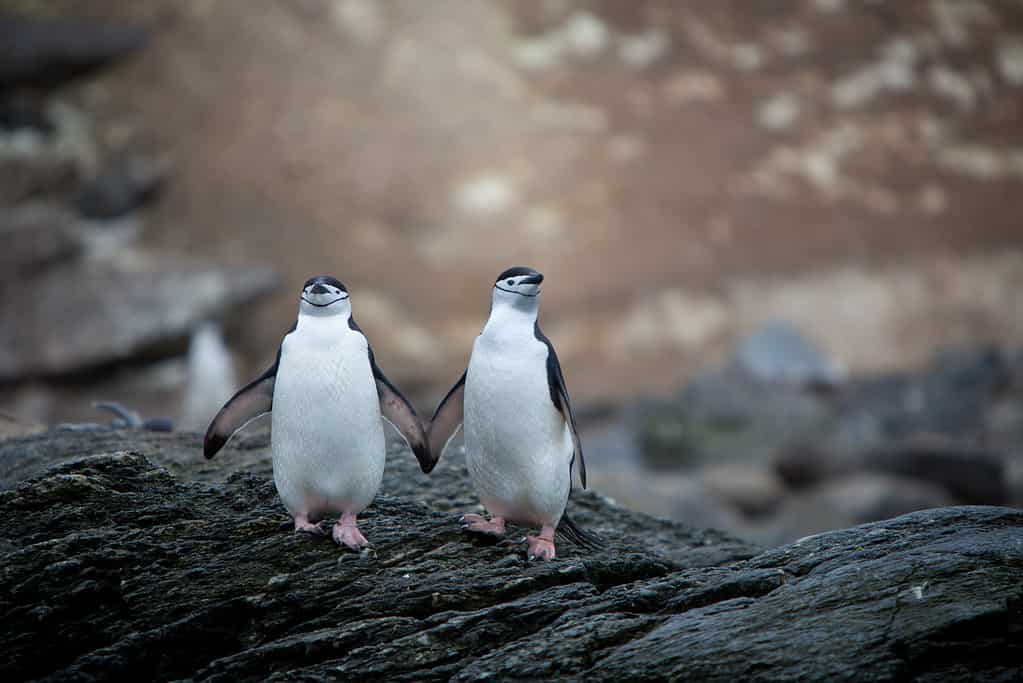
Chinstrap penguins usually mate for life.
©Chris Venne/Shutterstock.com
The Chinstrap penguin has the scientific name Pygoscelis antarcticus. Chinstrap penguins are sometimes referred to as P. Antarctica, a prior scientific name for the species. Its family name is Spheniscidae, and the class to which it belongs is Aves.
The chinstrap penguin is also called the ringed penguin, bearded penguin, and stone cracker penguin, which is a name given because of its loud noisy call. The origin of the name penguin is not really known. It is possibly from the Welsh word, “pen” for the head, and “Gwyn” meaning white.
Species
The Pygoscelis family comprises three different penguins; together they are known as “brush-tailed” penguins.
- Chinstrap penguin (Pygoscelis antarcticus) – a medium-sized penguin with a black helmet and chin strap marking that inhabits a variety of islands and beaches in the Antarctic and Southern Pacific oceans.
- Adelie Penguin (Pygoscelis adeliae) – a medium-sized penguin with a black head and back found only on the coast of the Antarctic continent. It is one of the most widespread and southernly distributed of all penguins.
- Gentoo penguin (Pygoscelis papua) – is a medium-sized penguin with a black head that features a white marking from eye to eye, an orange bill, and a black back, that mostly inhabits the Falkland Islands and the Antarctic Peninsula.
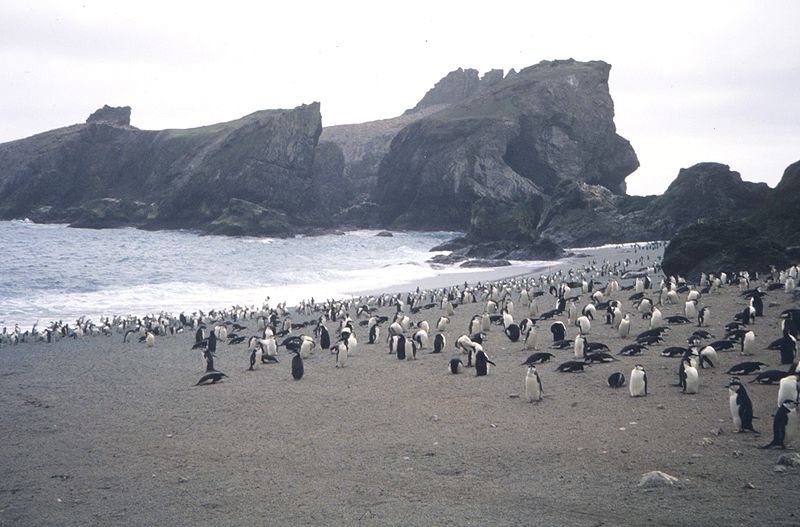
Some penguin species left Antarctica for warmer waters during the ice age.
©Lt. Philip Hall, NOAA Corps, Public domain, via Wikimedia Commons – License
Evolution
Fossil records indicate that all penguin’s common ancestors lived as long as 40 million years ago and were around five feet tall. They are believed to have originated in Antarctica, which was covered in forests at that time and connected to what would become New Zealand, Australia, South America, and surrounding islands. These ancient ancestors of penguins had diverged from the ancestors of petrels and albatrosses around 71 million years ago.
The arrival of the ice age 35 million years ago brought brutal changes to the ancient ancestors of the penguin. The continents of Australia and South America drifted away from Antarctica while ocean currents encircled it. This cooling climate likely killed the older penguins – leaving them to compete with whales for the same prey.
While most of the ancient penguins became extinct, others, like the macaroni penguin, swam to warmer waters to found new lineages. Species like the emperor penguin stayed in Antarctica and evolved adaptations suited to live in the cold environment. Chinstrap penguins are among the species that branched out to habitats beyond the Antarctic continent.
Appearance and Behavior
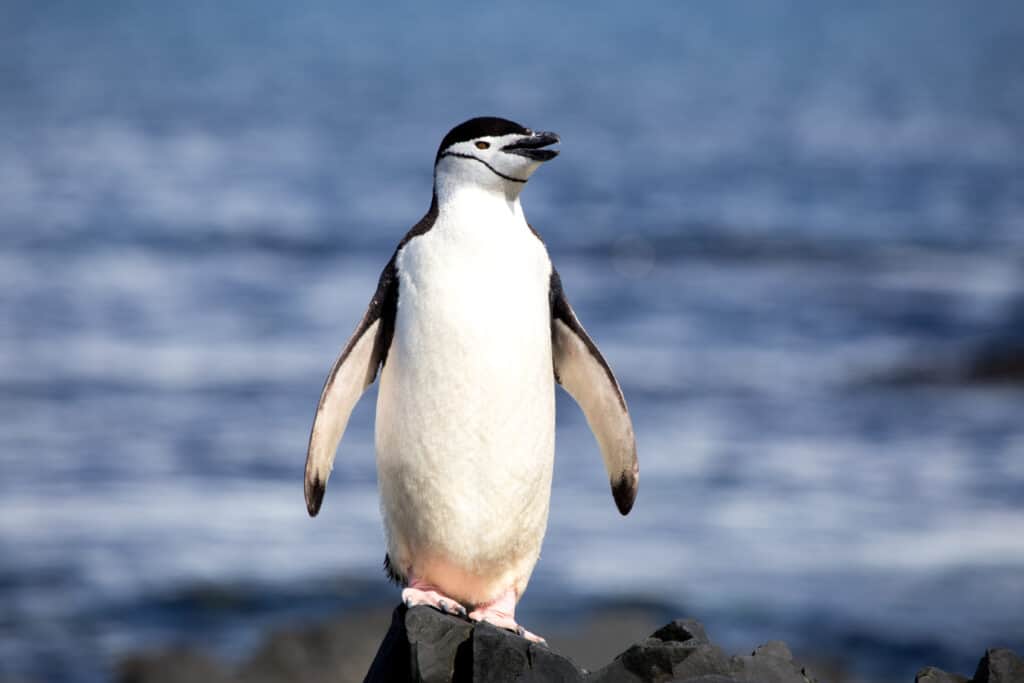
A chinstrap penguin is easily recognizable by its black helmet and black line under its chin.
©robert mcgillivray/Shutterstock.com
The chinstrap penguin actually looks like a bird wearing a black helmet with a black chinstrap – reminiscent of the first aviator helmets. Otherwise white-faced, the bills and eyes are blackish. Their feet are pink with black soles. Young penguins have gray faces and will develop adult markings in 14 months.
They are not the largest of penguins; the chinstrap penguin is of medium size. Their length is 75 cm (29 inches), and they have an average weight of 5.5 kg (12 pounds).
This penguin is known to be vocal and has an extremely loud voice when in its breeding colony. Chinstrap penguin sounds are very noisy; the penguin makes an “ah, kauk, kauk, kauk” as it raises its flippers and sways its head from side to side.
Chinstrap breeding colonies are not boring. They don’t just sit around in the sun – fights break out with much head waving and flipper flipping. Chinstraps call to each other in loud, shrill voices, bow, gesture, and preen their coats. If a territorial dispute occurs, they may stare, point and charge.
The chinstrap penguin is very social and can be found in colonies with the Adélie penguin, cormorants, or other similar penguins. Their nests are simple and in rocky hollows. When it comes to defending against other species and each other, they are the most aggressive of the brush-tailed penguins.
A group of penguins is called a colony. Other names for the same group include Waddle or Rookery. A group of floating penguins on the ocean are called a raft.
Habitat

Chinstrap penguins follow schools of krill to warmer seas during the autumn months.
Image: Greens and Blues, Shutterstock
©Greens and Blues/Shutterstock.com
Sometimes chinstraps roost on ice with other penguin breeds, such as the Adélie penguin. Considered the most aggressive of penguins, they spend much of their life out at sea, where they might feed on small fish and krill.
They live in Antarctica and in the Scotia Sea, the South Orkneys, the South Shetland Islands, and the South Sandwich Islands, where the largest of their colonies are found. They dwell on the beachfront of the Southern Ocean and are often in rocky or sandy habitats. A few hundred birds live not far from New Zealand, in the Balleny Islands in the Ross Dependency area.
In early April, which is autumn in the southern hemisphere, the chinstrap penguin follows the schools of krill as they migrate further north to warmer waters with less ice.
Diet
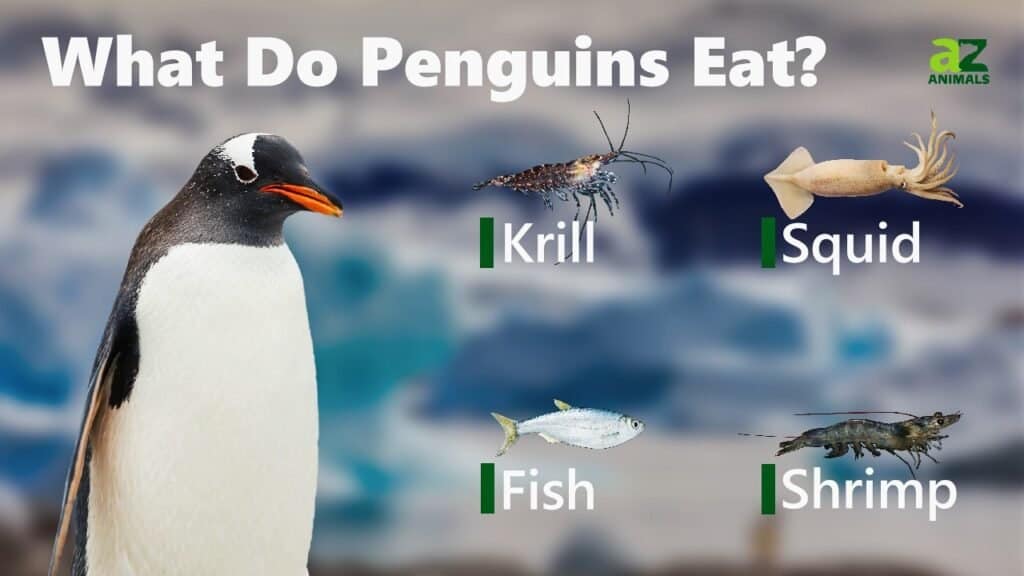
The chinstrap penguin enjoys diving. It may catch some fish, squid, and shrimp, but the vast majority of its diet comes from eating krill. With an estimated biomass of 379 million tons in the Southern Ocean, krill are abundant in the waters near where chinstrap penguins have their colonies.
However, with the mean air temperature rising dramatically (as much as 5 to 6 degrees Celsius) in many of the areas penguins hunt krill, the rise and fall of krill populations have been hypothesized to be the driving factor in the fluctuations of penguin populations.
Predators and Threats
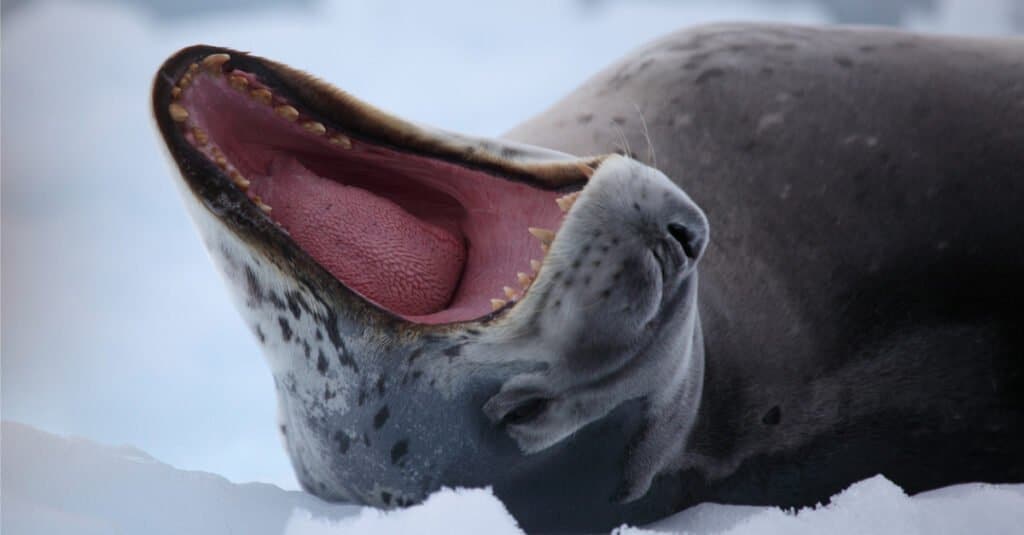
Leopard seals can eat up to 5% of a chinstrap penguin colony during a breeding season.
©iStock.com/MogensTrolle
The main predators of the adult chinstrap penguin are leopard seals and killer whales. Studies of leopard seals have shown they can eat 1.4 to 5% of a colony of penguins during a breeding season. Leopard seals rely on stealth to hunt chinstrap penguins. They wait along the edges of ice sheets where penguins have congregated and catch penguins as they enter the water. Generally, once chinstrap penguins have entered open water they face fewer threats.
Other predators include sea lions and sharks. The eggs and chicks are in danger from skuas, predatory sea birds. The largest threat to chinstrap penguins – as with other penguins species – is climate change which has affected the abundance of krill.
Reproduction, Babies, and Lifespan

Chinstrap penguins tend to mate for life and share chick-rearing responsibilities.
Image: Air Images, Shutterstock
©Air Images/Shutterstock.com
Returning to the colony when seeking his mate, the male will beat on his chest with his flippers while raising his head to make a screeching sound. Other males often echo the same unique chinstrap penguin sounds when one has started to screech. Once the chinstrap penguin has found a mate, he will return to the same one every year; mating pairs reunite to form a special bond.
The breeding season is November/December through March. The chinstrap penguin lays two eggs; the timing is usually later than other penguin species nearby. Eggs are hatched by both the mother and father, who do shifts of 5 to 10 days. After about 37 days, the eggs hatch. The baby chick stays with its parents for about a month. Then it moves on to be with a group of young chicks.

Chinstrap penguin chicks have fluffy gray down until it is replaced with waterproof feathers at around two months.
Image: Air Images, Shutterstock
©Air Images/Shutterstock.com
A baby penguin is called a chick. They also might be referred to as nestlings. A group of baby penguins is called a crèche, where the chicks huddle together for warmth and against predators. This allows the parents to go hunting for food to bring back. After about two months, the fluffy down is replaced by waterproof feathers, and the chick is now ready to make their first trip to sea to hunt on their own.
The chinstrap penguin lives to be about 20 years old. The reported oldest living chinstrap penguin in North America was 32 years old in 2015 and was living in Moody Gardens in Texas.
Population
In August 2018 the IUCN estimated that the population of chinstrap penguins at 8 million individuals. They are the most abundant of all penguin species and are listed as “Least Concern,” although their population is declining overall.
They are found on Circumpolar, Sub Antarctic, and Antarctic islands, and the Antarctic Peninsula. When breeding, they are not on the ice but remain on the rocky coast. The most populous colony of chinstrap penguins is found on Zavodovski Island, which is an island in the South Sandwich Islands.
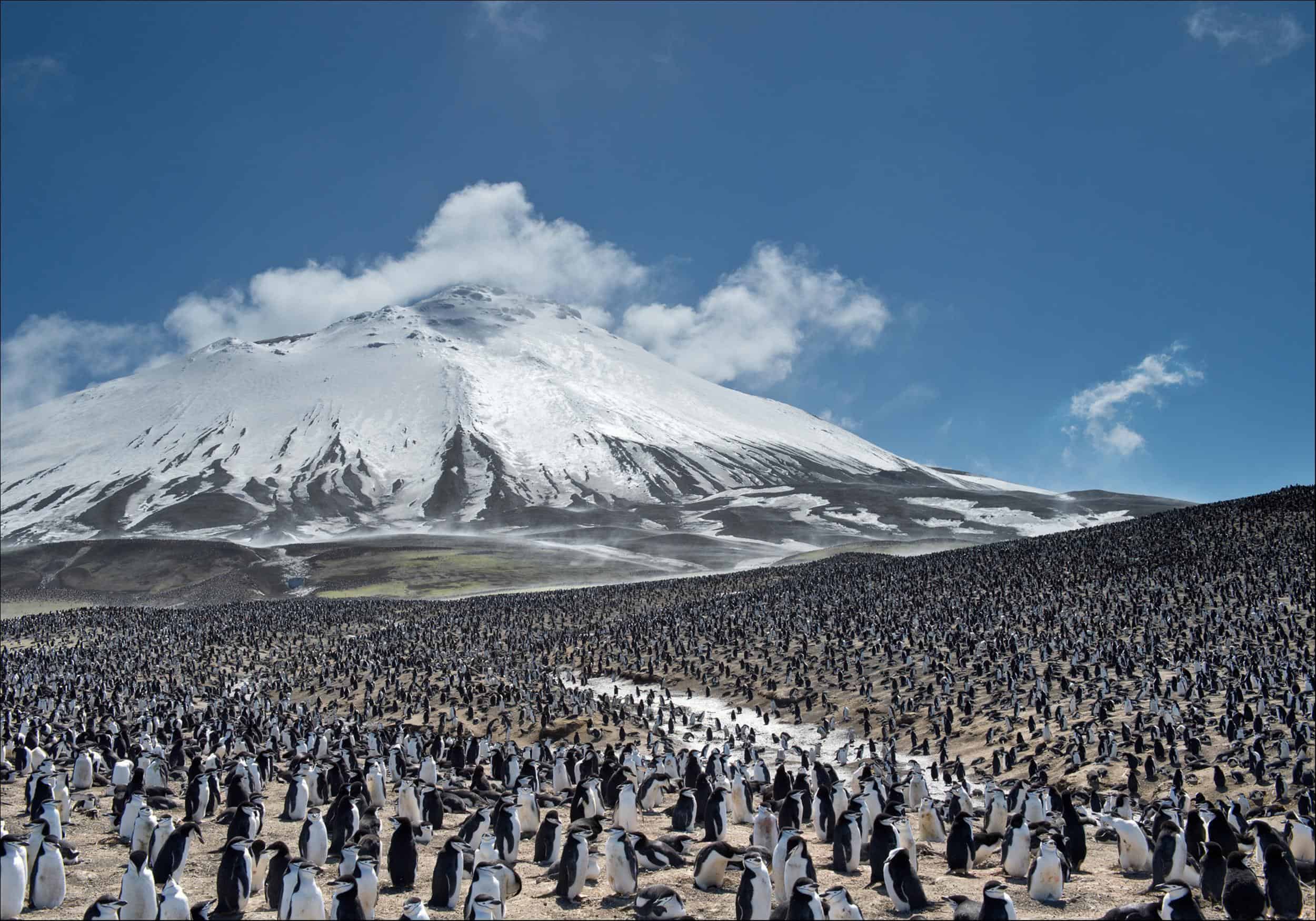
While Zavodovski Island is just 3 miles (5 km) long and 3 miles wide, it supports more than a million breeding pairs of chinstrap penguins!
Beyond Antarctica, chinstrap penguins have also been seen in the following areas:
- Argentina
Bouvet Island
- Chile
- The Falkland Islands
- French Southern Territories
South Georgia
- South Sandwich Islands
- Islands of New Zealand
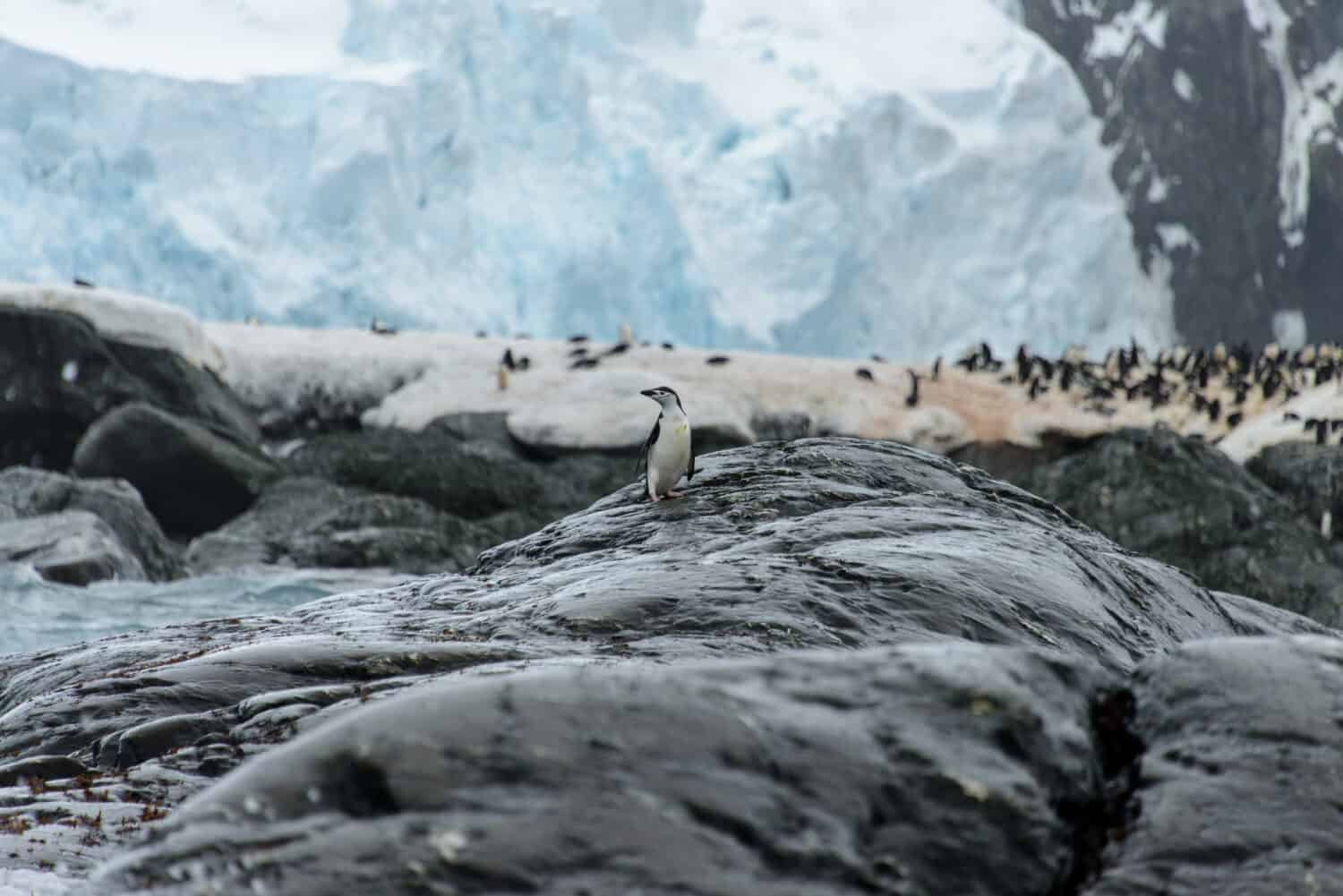
The chinstrap penguins’ numbers remain large because it ranges over diverse habitats.
Image: Greens and Blues, Shutterstock
©Greens and Blues/Shutterstock.com
More Chinstrap Penguin Facts
Their largest colony has been called “the smelliest place on Earth!”
With more than a million breeding pairs of penguins on a tiny island that’s just 3 miles (5 km) wide, you can imagine Zavodovski island is a pretty smelly place. However, beyond penguin droppings, sulfuric air from an active volcano on the island also produces noxious smells. Hailed by the UK’s Telegraph as “the world’s smelliest place,” the island’s features have names like Stench Point, Pungent Point, and Noxious Bluff.
A volcano also threatens their largest colony
The stratovolcano on the island housing the largest colony of chinstrap penguins is named Mount Curry, and it began erupting in March 2016. The eruption covered much of the island in ash but also came at a time that chinstrap penguins had begun leaving their breeding grounds to forage at sea until the fall, which limited the impacts
Featured in Planet Earth II
The documentary series Planet Earth II filmed the chinstrap penguins on Zavodovski. Getting to the remote island took more than a year of planning and the documentary crew had to cross some of the roughest seas on earth just to capture this remote environment.
View all 235 animals that start with CChinstrap Penguin FAQs (Frequently Asked Questions)
Are chinstrap penguin carnivores, herbivores or omnivores?
The chinstrap penguin is considered a carnivore, as it eats squid, small fish, shrimp and krill. A carnivore eats other animals, so in the case of the chinstrap penguin, it eats other sea creatures. It does not eat seaweed or sea plants but relies on fish for its diet.
How fast can a chinstrap penguin swim?
In the sea, the chinstrap can swim up to 20 miles per hour. They like to swim every day in search of food. On land, they are known for their tobogganing skills, often sliding along on their stomachs.
Are chinstrap penguins endangered?
No. Like all penguin species, chinstrap penguins are threatened by climate change which has affected the abundance of their primary prey, which is krill. However, with a population of an estimated 8 million chinstrap penguins, today they are listed as “Least Concern.”
What Kingdom do Chinstrap Penguins belong to?
Chinstrap Penguins belong to the Kingdom Animalia.
What phylum do Chinstrap Penguins belong to?
Chinstrap Penguins belong to the phylum Chordata.
What class do Chinstrap Penguins belong to?
Chinstrap Penguins belong to the class Aves.
What family do Chinstrap Penguins belong to?
Chinstrap Penguins belong to the family Spheniscidae.
What order do Chinstrap Penguins belong to?
Chinstrap Penguins belong to the order Sphenisciformes.
What genus do Chinstrap Penguins belong to?
Chinstrap Penguins belong to the genus Pygoscelis.
What type of covering do Chinstrap Penguins have?
Chinstrap Penguins are covered in Feathers.
In what type of habitat do Chinstrap Penguins live?
Chinstrap Penguins live in rocky antarctic islands.
What is the main prey for Chinstrap Penguins?
Chinstrap Penguins prey on krill, fish, and shrimp.
What are some predators of Chinstrap Penguins?
Predators of Chinstrap Penguins include leopard seals, killer whales, and sea birds.
What are some distinguishing features of Chinstrap Penguins?
Chinstrap Penguins have white faces and a thin, black line that runs under the chin.
How many babies do Chinstrap Penguins have?
The average number of babies a Chinstrap Penguin has is 2.
What is an interesting fact about Chinstrap Penguins?
There are 7 million breeding pairs of Chinstrap Penguins!
What is the scientific name for the Chinstrap Penguin?
The scientific name for the Chinstrap Penguin is Pygoscelis Antarcticus.
What is the lifespan of a Chinstrap Penguin?
Chinstrap Penguins can live for 15 to 20 years.
How to say Chinstrap Penguin in ...
Thank you for reading! Have some feedback for us? Contact the AZ Animals editorial team.
Sources
- David Burnie, Dorling Kindersley (2011) Animal, The Definitive Visual Guide To The World's Wildlife
- Tom Jackson, Lorenz Books (2007) The World Encyclopedia Of Animals
- Richard Mackay, University of California Press (2009) The Atlas Of Endangered Species
- David Burnie, Dorling Kindersley (2008) Illustrated Encyclopedia Of Animals
- Dorling Kindersley (2006) Dorling Kindersley Encyclopedia Of Animals
- A. Atkinson, V. Siegel, E.A. Pakhomov, M.J. Jessopp, V. Loeb, Available here: https://www.iced.ac.uk/documents/Atkinson%20et%20al,%20Deep%20Sea%20Research%20I,%202009.pdf
- DAVID G. AINLEY, GRANT BALLARD, BRIAN J. KARL and KATIE M. DUGGER, Available here: https://www.landcareresearch.co.nz/publications/researchpubs/Leopard_seal_predation_rates.pdf
- Guinness Book of World Records, Available here: https://www.guinnessworldrecords.com/world-records/largest-penguin-colony/
- IUCN Red List, Available here: https://www.iucnredlist.org/species/22697761/132601557

